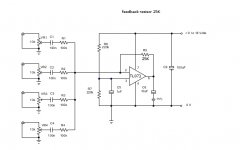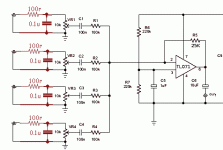Hi I am playing wav files that have been recorded on to a SD card and played on a Sparkfun Tsunami Super WAV Trigger, these features eight analog outputs, with True line-level stereo output: 2.1V RMS ground cantered. This player gives a clean signal played through headphones.
However I have made two players. Each player with four mono outputs played though a homemade mixer.
The problem is that the output from both mixers are producing a high pitched noise/ whistle at a frequency of 1323hz this noise starts with playing the files and carries on for approximately 45seconds after they have stopped.
With all the mixer pots turned down the whistle is still there but reduced in volume. But with one pot only turned up the whistle disappears altogether.
Although both players are much the same (but slightly different layout), they behave differently.
One of the players with mixer produces a clean signal played into a solid state guitar amp, but when played through a small TDA7266 Audio Amplifier Module produces the whistle.
The second player with mixer produces the whistle whatever it is played through.
I would like to know what is happening and what I can do to solve the problem.
However I have made two players. Each player with four mono outputs played though a homemade mixer.
The problem is that the output from both mixers are producing a high pitched noise/ whistle at a frequency of 1323hz this noise starts with playing the files and carries on for approximately 45seconds after they have stopped.
With all the mixer pots turned down the whistle is still there but reduced in volume. But with one pot only turned up the whistle disappears altogether.
Although both players are much the same (but slightly different layout), they behave differently.
One of the players with mixer produces a clean signal played into a solid state guitar amp, but when played through a small TDA7266 Audio Amplifier Module produces the whistle.
The second player with mixer produces the whistle whatever it is played through.
I would like to know what is happening and what I can do to solve the problem.
Attachments
Last edited:
As general practice, I'd put 33 pf ceramic cap across R6 to cut ultrasonic gain, and I'd put 0.1 uf ceramic caps within 1" of the op amp on the power traces.
I'd put 33 pf ceramic caps between each RCA center and ring.
inputs of the other side are shorted together with a resistor? Or used on the other channel?
Cheaper than buying a scope to see if it is oscillating ultrasonicly or not.
I'd put 33 pf ceramic caps between each RCA center and ring.
inputs of the other side are shorted together with a resistor? Or used on the other channel?
Cheaper than buying a scope to see if it is oscillating ultrasonicly or not.
Since you're driving a load (headphones) with this, the current drawn by the op-amp can cause the positive supply voltage to drop. The op-amp is normally insensitive to this, but the circuit biasing the + input of the op-amp does respond to the change in sully voltage, albeit low-pass-filtered by the resistors and the 1uF cap.
You could changing the cap to a larger value. The oscillations might stop, but more likely they'll just go to a lower frequency. The best solution is to use a Zener diode. In your voltage divider that biases the + input, replace R7 with a reverse-biased Zener diode, and replace R6 with 5K or so. The value of the Zener should be about half of your supply voltage. This solution does require you to pick a permanent value for your supply voltage.
Tom
You could changing the cap to a larger value. The oscillations might stop, but more likely they'll just go to a lower frequency. The best solution is to use a Zener diode. In your voltage divider that biases the + input, replace R7 with a reverse-biased Zener diode, and replace R6 with 5K or so. The value of the Zener should be about half of your supply voltage. This solution does require you to pick a permanent value for your supply voltage.
Tom
Last edited:
Your WAV players' DAC leaks supersonic clock.
ONE input, you do not hear it.
TWO or more inputs, the *difference* of the clock rates on the several DACs beats inside the opamp to produce the Difference Tone. (And apparently the DAC has a 45 second idle time-out.)
The Tsunami plan shows a supersonic filter on each audio output. But way up at 159KHz! For general use, I would try a simple 16KHz 1-pole R-C filter on every Tsunami output as shown.
If you truly need 20KHz response you should use a fancier filter at >20KHz. Study good DAC output stages (not all are "good" in the sense of complete suppression of clock pulses).
ONE input, you do not hear it.
TWO or more inputs, the *difference* of the clock rates on the several DACs beats inside the opamp to produce the Difference Tone. (And apparently the DAC has a 45 second idle time-out.)
The Tsunami plan shows a supersonic filter on each audio output. But way up at 159KHz! For general use, I would try a simple 16KHz 1-pole R-C filter on every Tsunami output as shown.
If you truly need 20KHz response you should use a fancier filter at >20KHz. Study good DAC output stages (not all are "good" in the sense of complete suppression of clock pulses).
Attachments
Many thanks for all your responses. I will investigate the use of all your suggestions.
Although I think that PRR is on the right track with the beating DACs producing a difference tone.
A potential problem with this idea is that if I unplug two of the inputs to the mixer (I have wired pairs of outputs from the Tsunami board with stereo jacks) the whistle is unaltered; can this still follow the logic of the beating DACs ?
If the DACs are producing a difference tone, why that is with all the mixer pots turned down the whistle is still there but reduced in volume, but with only one pot turned up all the way up the whistle disappears altogether. Could the resistor, pot resistance and cap combo in this configuration be producing the necessary R-C filter to work (It does my head in to work this out)? This also works this way with only two inputs( but with a sweet spot with the one not fully turned up).
Although I think that PRR is on the right track with the beating DACs producing a difference tone.
A potential problem with this idea is that if I unplug two of the inputs to the mixer (I have wired pairs of outputs from the Tsunami board with stereo jacks) the whistle is unaltered; can this still follow the logic of the beating DACs ?
If the DACs are producing a difference tone, why that is with all the mixer pots turned down the whistle is still there but reduced in volume, but with only one pot turned up all the way up the whistle disappears altogether. Could the resistor, pot resistance and cap combo in this configuration be producing the necessary R-C filter to work (It does my head in to work this out)? This also works this way with only two inputs( but with a sweet spot with the one not fully turned up).
Last edited:
- Status
- This old topic is closed. If you want to reopen this topic, contact a moderator using the "Report Post" button.

